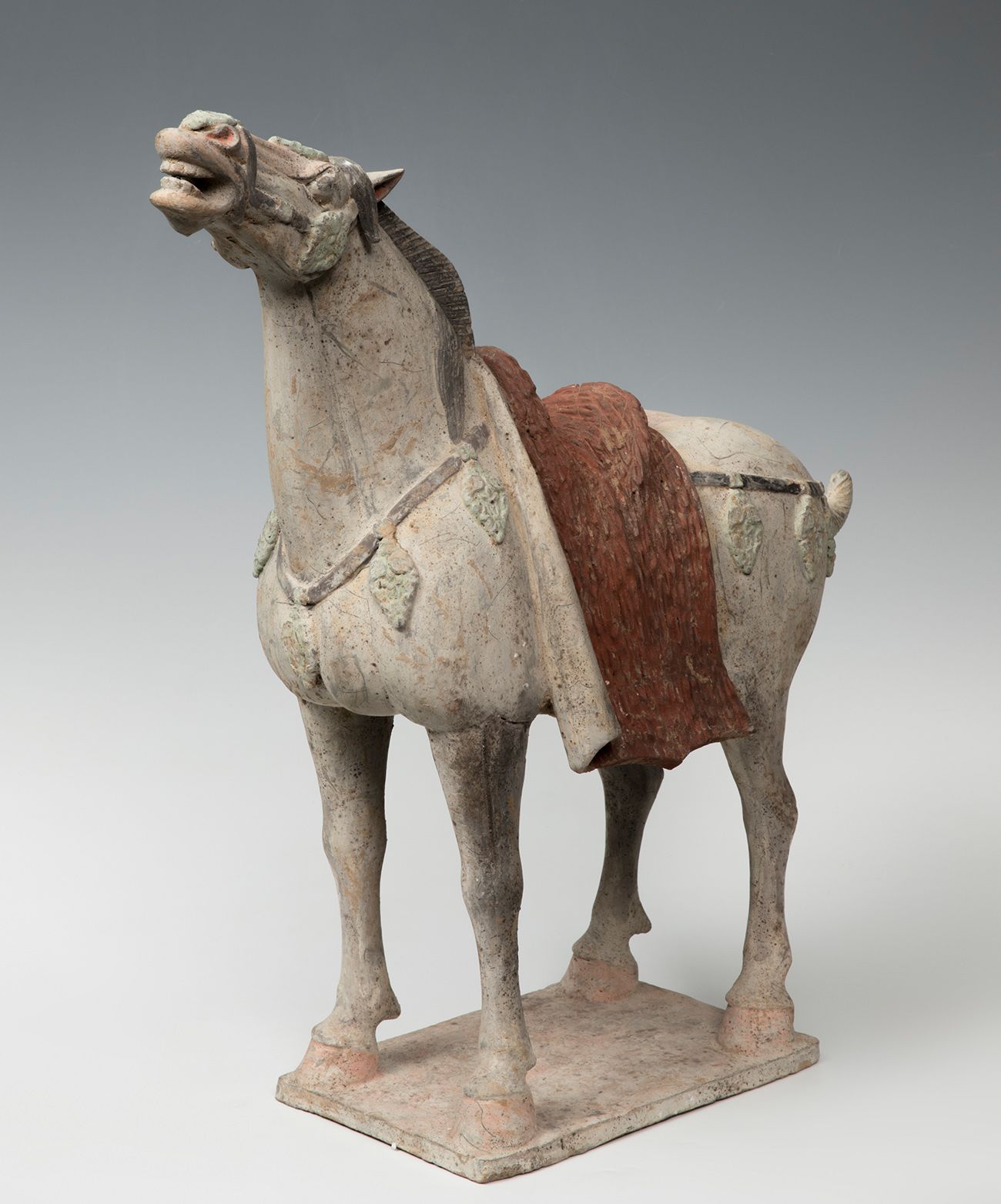Description
Horse; China, Tang Dynasty, AD 619-906. Polychrome terracotta. Thermoluminescence certificate enclosed. Measurements: 51 x 56 x 22 cm. Figure of a horse, made in polychrome terracotta, probably with the usual engobes of the period (cold-applied), which may have formed part of a funerary trousseau of a prominent member of the Tang Dynasty. It is notable for the naturalistic way in which the artist has portrayed it, capturing the face in detail and adopting a position through the open legs, with the head turned upwards. The Tang dynasty is considered by historians to be a period of splendour in Chinese civilisation, equal or even superior to the Han period. Emerging after a period of despotism under the cruel Yang Di, it was established by Li Shimin who, out of filial piety, put his father on the throne before assuming the role of emperor himself and founding the Tang dynasty. Stimulated by contact with India and the Middle East via the Silk Road, the Tang empire experienced a creative boom in many fields. Buddhism, which had emerged in India at the time of Confucius, continued to flourish during this period and was adopted by the imperial family, becoming an essential part of traditional Chinese culture. The development of the printing press also extended the dissemination of written works, giving rise to the golden age of Chinese art and literature, and the great cultural opening up resulted in a fundamentally colourful, expressive and highly eclectic art, although it remained primarily for funerary use, with the artist remaining an anonymous craftsman. However, from this time onwards, high-fired ceramics, decorated with enamels, would come to be used as a status symbol, with typologies such as vessels for the table of the litterateur and all types of tableware. Terracotta, on the other hand, continued to be used for grave goods, although stoneware would also be used from now on, especially for the tombs of nobles and scholars. In funerary pieces, the group to which these bears belong, an important novelty was introduced: tricolour lead glazes (sancai), although pieces decorated with engobes continued to be made. Among the grave goods, there are six typological groups, each with a great variety: tomb guardians, with warriors and protective beasts; ceremonial figures with their servants; animals of all kinds, such as oxen, camels and horses; musicians and court ladies; utensils and vessels; and finally, architectural models. Three periods can also be distinguished. The first of these, between 681 and 683, is dominated by figures decorated with engobes, but not yet glazed, so that the pieces presented here could be dated to between these years. The second period, between 683 and 779, is the great Sancai period, with a predominance of enamel. Finally, until the beginning of the 10th century, pieces with Sancai enamels continued to be made, albeit of lower quality than those of the previous period.
14
Horse; China, Tang Dynasty, AD 619-906. Polychrome terracotta. Thermoluminescence certificate enclosed. Measurements: 51 x 56 x 22 cm. Figure of a horse, made in polychrome terracotta, probably with the usual engobes of the period (cold-applied), which may have formed part of a funerary trousseau of a prominent member of the Tang Dynasty. It is notable for the naturalistic way in which the artist has portrayed it, capturing the face in detail and adopting a position through the open legs, with the head turned upwards. The Tang dynasty is considered by historians to be a period of splendour in Chinese civilisation, equal or even superior to the Han period. Emerging after a period of despotism under the cruel Yang Di, it was established by Li Shimin who, out of filial piety, put his father on the throne before assuming the role of emperor himself and founding the Tang dynasty. Stimulated by contact with India and the Middle East via the Silk Road, the Tang empire experienced a creative boom in many fields. Buddhism, which had emerged in India at the time of Confucius, continued to flourish during this period and was adopted by the imperial family, becoming an essential part of traditional Chinese culture. The development of the printing press also extended the dissemination of written works, giving rise to the golden age of Chinese art and literature, and the great cultural opening up resulted in a fundamentally colourful, expressive and highly eclectic art, although it remained primarily for funerary use, with the artist remaining an anonymous craftsman. However, from this time onwards, high-fired ceramics, decorated with enamels, would come to be used as a status symbol, with typologies such as vessels for the table of the litterateur and all types of tableware. Terracotta, on the other hand, continued to be used for grave goods, although stoneware would also be used from now on, especially for the tombs of nobles and scholars. In funerary pieces, the group to which these bears belong, an important novelty was introduced: tricolour lead glazes (sancai), although pieces decorated with engobes continued to be made. Among the grave goods, there are six typological groups, each with a great variety: tomb guardians, with warriors and protective beasts; ceremonial figures with their servants; animals of all kinds, such as oxen, camels and horses; musicians and court ladies; utensils and vessels; and finally, architectural models. Three periods can also be distinguished. The first of these, between 681 and 683, is dominated by figures decorated with engobes, but not yet glazed, so that the pieces presented here could be dated to between these years. The second period, between 683 and 779, is the great Sancai period, with a predominance of enamel. Finally, until the beginning of the 10th century, pieces with Sancai enamels continued to be made, albeit of lower quality than those of the previous period.
